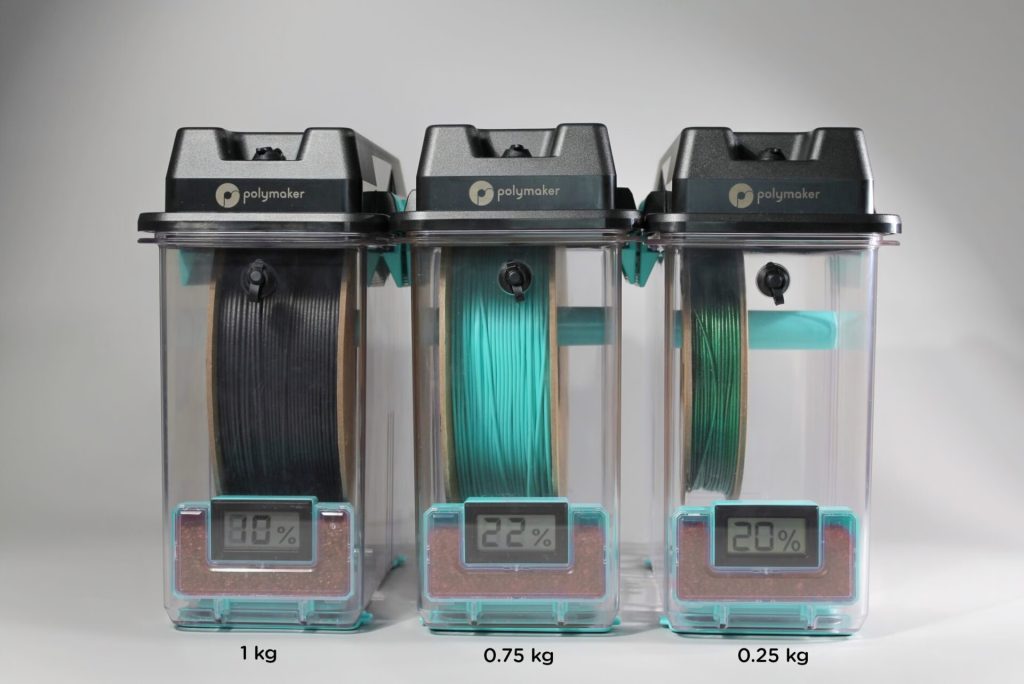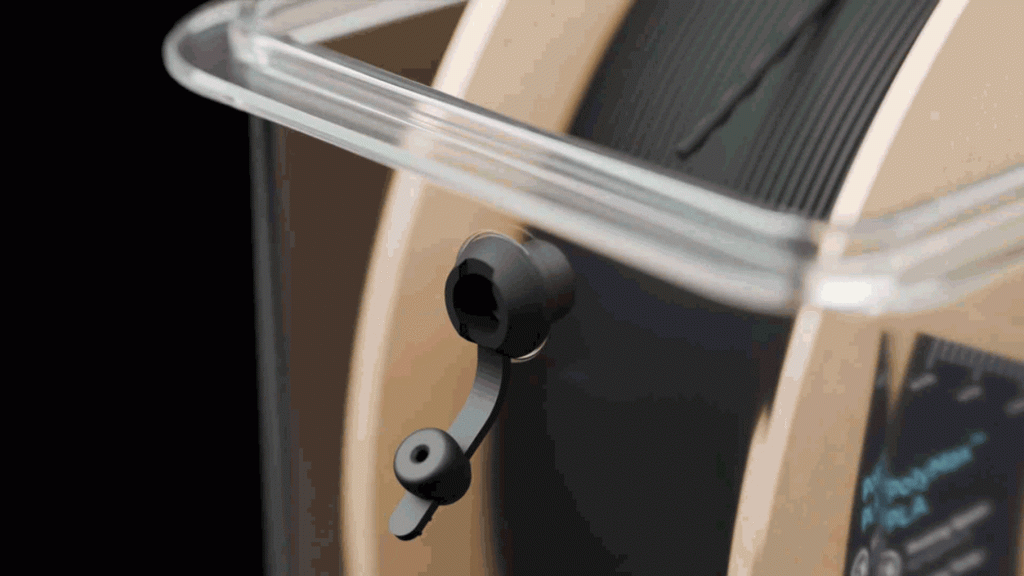How you store 3D printing polymaker filament can significantly impact 3D printing projects because filaments absorb moisture from the air.
Filaments affected by moisture are prone to stringing, clogging, and rough surfaces, and those risks increase with faster print speeds.
You can keep your filaments in an airtight container or vacuum-sealed bag with desiccant packs to keep moisture at bay, but these solutions eventually require removing the filament to print, breaking that precious moisture seal.
Polymaker offers a genius solution – the PolyDryer – designed to enhance print quality and keep all your 3D printing polymaker filaments as dry as a bone.

The advantage of the PolyDryer is three-fold:
- It stores filament in an airtight container.
- It dries the filament with 360° airflow.
- It stays sealed during 3D printing workflows.
The PolyDryer ensures your filament is never adversely affected by moisture, and its drying feature can sometimes salvage moist filaments.
The by-products are less material waste, higher-quality builds, fewer print failures, and automated drying, saving you time.
The PolyDryer Box
The PolyDryer was created as a solution to a head-scratching problem: how to keep 3D printing filaments dry 100% of the time.
Taking filaments out of their sealed boxes to print exposes the plastic to moisture over several hours or even days at a time.

Dehumidifiers can only reduce moisture in the air so much, and the longer the filament absorbs moisture, the less useful it becomes.
The PolyDryer’s ingenious design uses a filament feed-through hatch, so filament stays in the sealed box while your printer pulls it through.
You never have to worry about damaging your polymaker filament in humid environments because the PolyDryer Box provides a sealed environment.
Drying mode
Insert your filament spool into the PolyDryer Box, and you can select a drying mode for specific materials like PLA, PETG, ABS, ASA, TPU, PVB, PC, PA, and PVA, as well as Polymaker PolyMide PA12 (a Nylon 12 filament).
Drying times vary from 6 to 24 hours, depending on the material. Once dry, the drying stage need not be activated again.
It’s so effective that you can even salvage old material that would otherwise end up in your recycling bin. There are 3 preset power levels for drying, with the most intensive offering a solution to very moist filaments.
Closing the airlocks as soon as the drying cycle has finished ensures a dry environment, but if you can’t do this, you can set it to continuous mode, which continues drying the filament until you’re able to reseal after a drying cycle.
Polymaker filaments
Polymaker also develops its own filaments, specialising in PLA and derivatives that enhance performance and mimic other thermoplastics.
A rundown:
A matte-surface PLA that’s easy to print, with excellent bridging and overhang qualities, compatible with all extrusion-based 3D printers.
Offers fast extrusion rates, high precision, and exceptional layer adhesion, allowing for increased printer speeds without compromising strength or quality.
Tough PLA for high-speed printing offers durability comparable to ABS, impact strength similar to ABS, and bending strength surpassing ASA and PETG.
An impact-modified version of PolyTerra PLA, offering increased toughness and durability and a more satin finish suitable for applications requiring higher rigidity.
A PLA filament containing 30% post-industrial recycled PLA. It maintains print quality and characteristics while improving sustainability. It comes in a matte black finish.
A reliable PLA with high tensile strength and rigidity and a wide colour range, including special effects like silk, dual silk, glow-in-the-dark, galaxy, starlight, and colour-changing variants.
Combines high toughness with high rigidity, offering engineering properties while maintaining the ease of printing associated with regular PLA.
A PLA filament reinforced with 8% milled carbon fibres. It provides increased rigidity and produces parts with a carbon black surface finish. The carbon fibres also help reduce shrinkage during printing.
A low-density PLA using Polymaker’s Stabilised Foaming technology. It has a 30% lower density than regular PLA and produces a naturally matte surface finish.
Version A is excellent for sanding and ideal for helmets and detailed parts, while Version B is tougher and suitable for props that might encounter impacts.
The most durable PLA in Polymaker’s range, outperforming ABS mechanically while retaining PLA’s ease of use. It offers five times the impact resistance of regular PLA.
A wood-mimicking PLA without wood powder fillers and a unique matte surface finish perfect for building wood-effect fixtures.
Summing up
We recommend Polymaker filaments if you want to benefit from unique mechanical characteristics compared to standard PLA, such as lower density (PolyLite LW-PLA), ABS-like durability (PolyMax PLA), and sandability (CosPLA).
The Polymaker PolyDryer then adds a unique tool for professional makers to improve the quality of 3D prints by keeping filaments bone dry.
Polymaker’s internal tests show the humidity in the PolyDryer increases by less than 5% in 30 days with 1.5 times better sealing than a standard storage box.
All Polymaker spools of 1kg or less are compatible with the PolyDryer, and the same goes for most third-party brands (check with them first).




